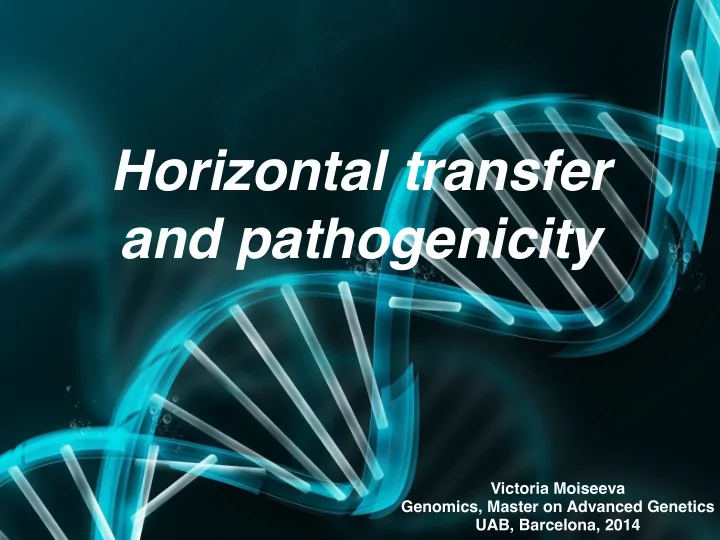

Horizontal transfer and pathogenicity Victoria Moiseeva Genomics, Master on Advanced Genetics UAB, Barcelona, 2014
INDEX • Horizontal Transfer • Horizontal gene transfer mechanisms • Detection methods of HGT • Examples Staphylococcus aureus Escherichia coli • Conclusion • References
Horizontal transfer Horizontal gene transfer is a process in which exogenic DNA is introduced and integrated into a recipient genome. The most transferred: transposable elements functional genes regulatory sequences All three domains: Archaea, Bacteria, and Eukarya
Importance Several novel multi-resistant and/or hyper-virulent ‘‘superbugs’’ emerged over the last years as a result of horizontal acquisition of antibiotic resistance and virulence genes, causing serious outbreaks. recognize and predict virulent strain emergence and epidemics • formulate protective public health policies and maneuvers • develop or modify vaccines •
Horizontal gene transfer mechanisms A. Transformation B. Generalized transduction C. Conjugation
Detection methods (i) difference between gene trees derived from a limited number of gene families and the reference trees such as the small-subunit ribosomal RNA (SSU rRNA) tree or whole genome tree; (ii) unexpectedly high sequence similarity of a gene from two distant genomes compared with those among homologous genes in closely related genomes; (iii) unusual nucleotide composition or codon usages of a gene compared with the rest of the genes within a genome.
Analyze of 116 prokaryotic complete genomes shows 46,759 ( ∼ 14%) of the total 324,653 ORFs were derived from recent horizontal transfers (Table 1). The average proportion of HT genes per genome was ∼ 12% of all ORFs, ranging from 0.5% to 25% depending on prokaryotic lineage. Nakamura et al. Nature Genetics 36, 760 - 766 (2004)
4 main functional categories • plasmid, phage and transposon functions (28.3%) • cell envelope (13.8%) • regulatory functions (11.0%) • cellular processes (10.0%) Nakamura et al. Nature Genetics 36, 760 - 766 (2004)
Pathogenicity islands Pathogenicity islands: a subset of genomic islands characterized by their capacity to encode virulence functions. • adhesion and invasion • type-III secretion systems for altering host cell metabolism • toxin production • a host of metabolic capabilities (e. g. acquisition of phosphate and iron at low concentrations) Nakamura et al. Nature Genetics 36, 760 - 766 (2004)
The pathway to pathogenicity While the introduction of pathogenicity islands by horizontal gene transfer is considered a hallmark in the evolution of pathogenic bacteria, this process represents only one step in a multi- faceted and complex evolutionary process. Nakamura et al. Nature Genetics 36, 760 - 766 (2004)
Staphylococcus aureus Has the potential to cause from benign skin infections to severe diseases, such as septicaemia, osteomyelitis and endocarditis. Genomic island responsible for the spread of methicillin resistance encoding gene mecA among S. aureus is termed the staphylococcal cassette chromosome mec (SCCmec) It has been hypothesized that SCCmec island originated in Staphylococcus epidermidis and was acquired in the process of evolution of S. aureus by horizontal gene transfer Juhas, 2013 Informa Healthcare USA 1549-7828
Kriegeskorte et al. Nature Medicine 18 , 662–663 (2012)
Escherichia coli • E. coli is an extremely versatile bacterium • E. coli has the potential to cause life-threatening infections • Genomes of pathogenic E. coli strains can be 1Mb larger than those of non-pathogenic strains due to horizontal acquisition of genomic islands • The remarkable pathogenicity of the E. coli O104:H4 outbreak strain was the result of the combination of two horizontally acquired factors: increased Shiga toxin absorption and increased antibiotic resistance Juhas, 2013 Informa Healthcare USA 1549-7828
Conclusion Besides showing importance of novel technologies, the outbreaks also demonstrated the serious consequences of interspecies and intergenera horizontal transfer of virulence genes.
References • “Pathogen-origin horizontally transferred genes contribute to the evolution of Lepidopteran insects” Zi-Wen Li, Yi- Hong Shen, Zhong-Huai Xiang and Ze Zhang. BMC Evolutionary Biology 2011, 11:356 • “Global extent of horizontal gene transfer” In-Geol Choi and Sung-Hou Kim Proc Natl Acad Sci USA. Mar 13, 2007; 104(11): 4489–4494. • Biased biological functions of horizontally transferred genes in prokaryotic genomes Yoji Nakamura, Takeshi Itoh, Hideo Matsuda & Takashi Gojobori. Nature 2004 • “Horizontal Gene Transfer in Prokaryotes: Quantification and Classification” Eugene V. Koonin, Kira S. Makarova, and L. Aravind. Annu. Rev. Microbiol. 2001. 55:709 – 42. • “Horizontal and Vertical Gene Transfer : The Life History of Pathogens” Jeffrey G. Lawrence, Contrib. Microbiol. Bsel, Karger, 2005 • “Evolutionary pathway to increased virulence and epidemic group A Streptococcus disease derived from 3,615 genome sequences” Waleed Nasser, Stephen B. Beresa, Randall J. Olsen, Melissa A. Dean, Kelsey A. et al. 2014 • “Staphylococcus aureus genomics and the impact of horizontal gene transfer” Jodi A. Lindsay. International Journal of Medical Microbiology 304 (2014) 103–109 • “Horizontal gene transfer in human pathogens” Mario Juhas. 2013 Informa Healthcare USA 1549-7828 • “Horizontal gene transfer boosts MRSA spreading” André Kriegeskorte & Georg Peters. Nature 2012.
Recommend
More recommend